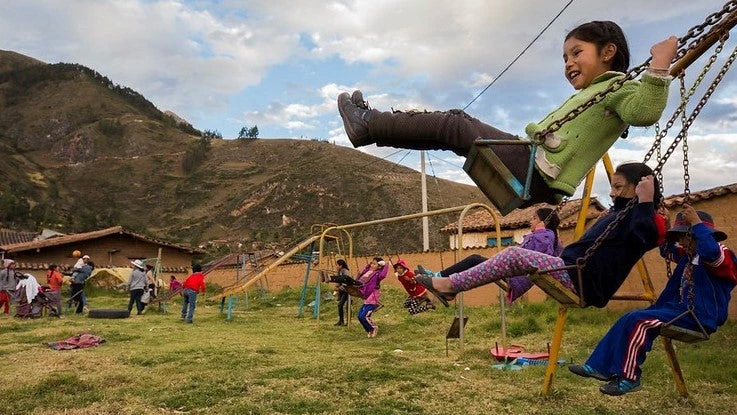 Children play at Demuna in Coyllurqui, Peru on June 7, 2018. Photo © Dominic Chavez/ International Finance Corporation
Children play at Demuna in Coyllurqui, Peru on June 7, 2018. Photo © Dominic Chavez/ International Finance Corporation
Machu Picchu – one of the seven wonders of the modern world – draws half a million people to the mountaintops of Peru each year. Another phenomenon has pulled public health experts and scientists, including World Bank experts, to Peru – that of childhood stunting.
For generations, the indigenous communities in Peru’s Andes suffered among the highest rates of childhood stunting in the world. Often more than half of the children in these mountaintop villages were physically and cognitively stunted. In fact, child stunting was so common, that Peruvians, including many doctors, didn’t initially recognize villagers’ short stature as a concern. Instead, they believed the indigenous people who lived in these communities were genetically predisposed to being extremely short.
Evidence and action proved otherwise. Research by the WHO and studies like INTERGROWTH-21st established that all children, regardless of ethnicity or heritage, experience similar linear growth patterns through age five if their nutritional and health needs are met. Further research revealed that stunting, beyond its nutritional consequences, is also associated with poor health and cognitive outcomes. Such damage during the first 1,000 days of a child’s life from the time they are conceived cannot be reversed. On the flip side, if we can prevent this damage to a child’s brain, this too cannot be reversed. This is a critical time window for young children. What happens in early childhood stays with them forever – strong brains build strong economies!
We know that undernourishment and diseases that cause stunting undermine brain development, leading to poor health and cognitive outcomes. Stunting can cast a shadow over a child’s life, diminishing their future learning and earning potential. And when large numbers of children are stunted, it diminishes a nation’s future prospects. In fact, a World Bank study estimates that stunting can shave as much as 10% off a country’s GDP per capita. So we need to do whatever we can to prevent stunting.
A country’s success and the market’s failure
From 2008 to 2017, Peru managed to cut their child stunting rate precipitously by more than half.
The critical follow-up question is: how might other countries replicate this extraordinary success? Other low-income countries such as Senegal and Malawi have achieved similar successes. But there is little information on how they succeeded and how others might follow. This points to a failure in the marketplace.
Across the global health sector, it has not been easy to understand or access resources identifying positive outliers, like Peru, across varied settings and geographies. There is an urgent need to collect and share best practices governments and funders might adopt and adapt to expedite progress against childhood stunting.
Addressing the market failure
Gates Ventures and the Bill & Melinda Gates Foundation, in partnership with organizations like the World Bank, the World Health Organization (WHO), and the Institute for Health Metrics and Evaluation (IHME), launched Exemplars in Global Health to facilitate South-South learning as a pathway to accelerating progress in health outcomes. The program has leading health researchers around the world working with in-country experts from the geographies that have made the most progress, and topic-specific partners like Scaling Up Nutrition (SUN) movement and the International Food Policy Research Institute (IFPRI) on key health topics to identify the policies, strategies, and programs that have helped drive their success.
Before Exemplars’ research, trials suggested WASH (water, sanitation, and hygiene) interventions had limited impact on stunting rates. But the Exemplars’ analysis of five stunting reduction outliers (Ethiopia, the Kyrgyz Republic, Nepal, Peru, and Senegal) shows WASH improvements have made a meaningful contribution to stunting reduction in three countries – Ethiopia, Nepal, and Senegal. In the case of Ethiopia, WASH improvements were estimated to have contributed as much as 17% of the reduction in stunting.
Exemplars’ research has helped get to the bottom of the success story in Peru. Building on research by the World Bank and the World Health Organization, Exemplars documented that Peru’s efforts included extending the health systems to poor communities, providing health insurance to poor women and children, and improving maternal care and preventive care for children. Along with a conditional cash transfer program, these measures helped improve health outcomes and reduced child stunting across the country.
Identifying the barriers
It is strange but true, that as valuable as this information is to health leaders around the world who want to improve health outcomes for their countries, the market was ill-prepared to provide it.
This demonstrates four barriers to progress in global health that philanthropists and funders are uniquely positioned to solve:
- The market often misses opportunities to serve those at the bottom of the pyramid.
- Philanthropists and funders can de-risk those investments to demonstrate the business case and bring the private sector to the table to address the growing challenge of malnutrition and the key role of food systems, especially as we see growing levels of obesity across the world
- Too few researchers are working across borders and across sectors to share perspectives and achieve new insights. South-South learning and collaboration are often underappreciated and underfunded. Philanthropy and governments can seed global cooperation on important research. It shouldn’t take a pandemic like COVID-19 to prompt global research cooperation.
- Research is often not translated into practice. A partnership between philanthropists and the World Bank allows such knowledge to be transferred to government partners who are designing and implementing large scale programs.
Through robust research and analysis over the past two years, the Exemplars team and its research partners have gained a better understanding of how countries have reduced childhood stunting rates and what economic benefits can be gained from this, building on research from the World Bank, among others. Further studies by the World Bank on success in reducing child stunting will follow soon, from another remarkably successful country – Malawi.
Sharing the knowledge
Importantly, Exemplars’ research partners have distilled their findings into data-driven actionable recommendations for leaders. We believe countries and funders can use the proven best practices identified by Exemplars to accelerate improvements in health and ensure funding is put to the best possible use.
Exemplars’ platform currently includes research on childhood stunting, under-five mortality, community health workers, and epidemic preparedness including COVID-19. It will soon be adding vaccine delivery.
There is no better time to invest in improving health and nutrition outcomes. National leaders from Bangladesh to Brazil and Ethiopia to Zambia have made remarkable progress. Let’s make sure the ranks of these outliers swell and that their remarkable health outcomes become the norm, not the exception.
We invite you to explore Exemplars’ findings at https://www.exemplars.health/



Join the Conversation